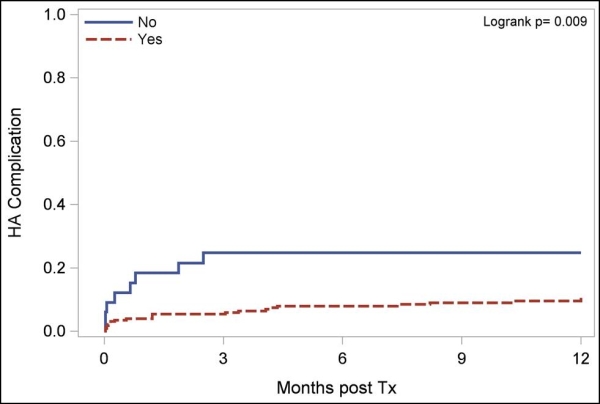Outcomes of Aorto-Hepatic Conduit During Liver Transplantation – A 31-Year, Single Center Experience.
Baylor University Medical Center, Dallas, TX.
Meeting: 2016 American Transplant Congress
Abstract number: C232
Keywords: Hepatic artery, Liver transplantation, Outcome, Surgical complications
Session Information
Session Name: Poster Session C: Liver Transplantation Complications and Other Considerations
Session Type: Poster Session
Date: Monday, June 13, 2016
Session Time: 6:00pm-7:00pm
 Presentation Time: 6:00pm-7:00pm
Presentation Time: 6:00pm-7:00pm
Location: Halls C&D
Introduction
Creation of aorto-hepatic conduits (AC) is often required during liver transplantation (LT). AC may be planned, or may be required urgently intraoperatively. This study was conducted to evaluate outcomes of LT with AC vs. without AC.
Methods
A single center, 31-year retrospective study of a prospectively-maintained database of LT recipients with and without AC was performed. Patients with AC created as a separate procedure were excluded. Donor and patient demographics were compared between the 2 groups, AC Cohort (n=272) and Control Group (n=3844). Primary endpoints were graft and patient survival, while secondary endpoints were biliary and HA complications.
Results
The AC Cohort had more re-transplants (p<0.01), more HCV (p<0.01), higher MELD scores (p<0.01), longer CIT (p<0.01), and more pRBC transfusions (p<0.01). The AC Cohort had similar graft survival (HR 0.94, 95%CI 0.77-1.13, p=0.22) and patient survival (HR 1.16, 95%CI 0.96-1.40, p=0.50) vs. the Control Group on multivariate analysis. Retransplantation predicted a significantly lower graft and patient survival (HR 2.84, 95%CI 2.53-3.19, p<0.01 and HR 1.37, 95%CI 1.21-1.55, p<0.01, respectively). Both groups had similar biliary and HA complications (p=0.22 and p=0.64, respectively). An increase in HA complications (p<0.01) was found when the AC was created using iliac artery from different donors (figure 1); however, there was no significant difference in graft (p=0.84) or patient survival (p=0.97).
Conclusion
The creation of AC during LT is associated with similar rates of graft and patient survival, and is an invaluable tool to re-establish arterial flow in difficult situations. The same donor iliac vessels should be used to create the AC to reduce HA complications.

CITATION INFORMATION: Gupta A, Anthony T, Goldstein R, McKenna G, Onaca N, Ruiz R, Testa G, Klintmalm G, Kim P. Outcomes of Aorto-Hepatic Conduit During Liver Transplantation – A 31-Year, Single Center Experience. Am J Transplant. 2016;16 (suppl 3).
To cite this abstract in AMA style:
Gupta A, Anthony T, Goldstein R, McKenna G, Onaca N, Ruiz R, Testa G, Klintmalm G, Kim P. Outcomes of Aorto-Hepatic Conduit During Liver Transplantation – A 31-Year, Single Center Experience. [abstract]. Am J Transplant. 2016; 16 (suppl 3). https://atcmeetingabstracts.com/abstract/outcomes-of-aorto-hepatic-conduit-during-liver-transplantation-a-31-year-single-center-experience/. Accessed December 26, 2025.« Back to 2016 American Transplant Congress
